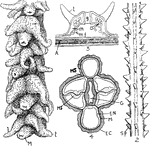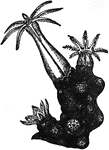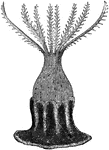Clipart tagged: ‘polyps’

Antipatharians
"Structure of Antipatharians. 1. A group of polyps--M. mouth; t., tentacles. 2. Axis without polyps…

Coral
"Coral is the name applied to the stony structures secreted by many of the actinozoa, and applied to…

Coral
"Coral is the name applied to the stony structures secreted by many of the actinozoa, and applied to…

Coral
An illustration of coral. Corals are marine organisms from the class Anthozoa and exist as small sea…

Freshwater Polyp
"Fresh-water polype (hydra), two specimens, the one expanded the other contracted, showing multiplication…

